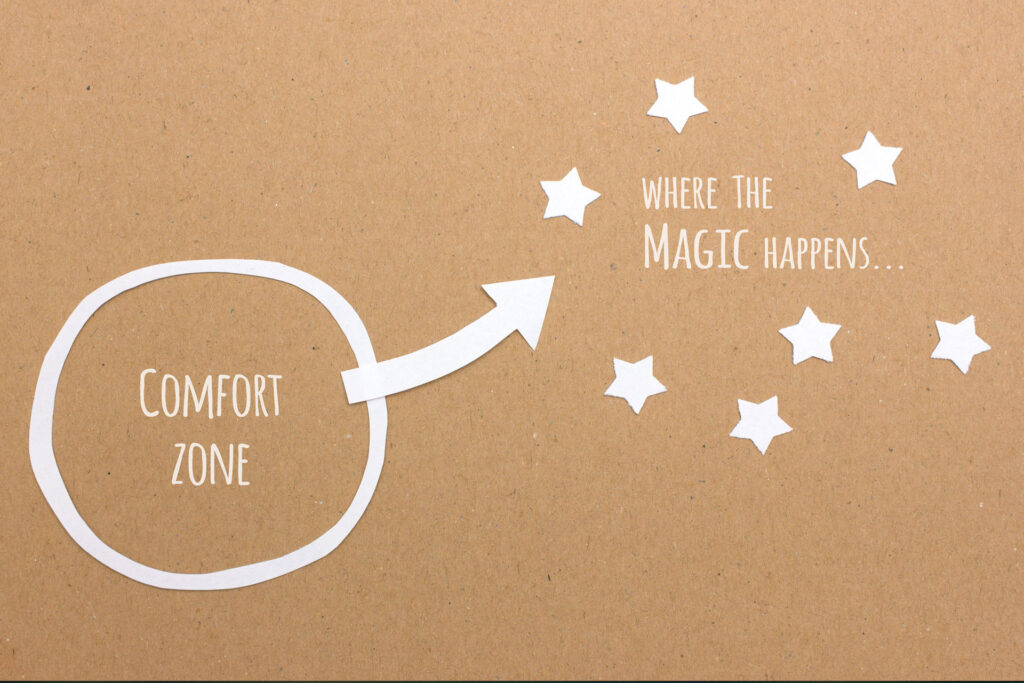As we kick off a new year, millions of us are setting goals, intentions, or resolutions—roughly 66 percent of Americans, to be exact. Yet, the statistics paint a grim picture. By midyear, fewer than half will have stuck to their resolutions, and by December, only 9 percent will have achieved their goals.
That means that of the 221 million people who are setting goals this month, 201 million will quit. So why does this cycle repeat year after year?
The answer exists in how we approach discomfort. Goals inherently require habit and behavior changes, which are often uncomfortable. But instead of building resilience and learning to sit with discomfort, many of us avoid it altogether. What if the key to lasting change and success lies not in striving for perfection but in embracing discomfort?
Inside the Chrysalis: Transformation Through Discomfort

Consider the metamorphosis of a caterpillar into a butterfly. Inside the chrysalis, the caterpillar’s body breaks down into a “soup” of cells, with imaginal discs—specialized cells—reorganizing to form the butterfly. This process is resource-intensive, requiring the complete dissolution and rebuilding of the caterpillar.
When the butterfly is ready to emerge, it must struggle to break free from the chrysalis. This struggle strengthens its wings, preparing it for flight. Without this effort, the butterfly’s wings would remain too weak to support its survival. The transformation is both uncomfortable and necessary, a vivid reminder that growth often demands discomfort.
The Cost of Avoiding Discomfort
Modern conveniences—instant food delivery, climate control, and technology—have made our lives easier, but they’ve also diminished our ability to tolerate discomfort. This avoidance comes at a cost:
- Reduced Resilience: Avoiding discomfort weakens our “muscle” for handling adversity, making challenges feel disproportionately overwhelming.
- Increased Anxiety: Our brains are wired to detect threats. In the absence of true dangers, this “threat radar” reacts to minor issues—social discomfort or perceived inadequacies—as though they’re life-threatening.
- Missed Growth Opportunities: Discomfort accompanies growth. Avoiding it means sidestepping the difficult conversations, risks, and failures that help us expand our capacity to handle challenges.
- Overreliance on Instant Gratification: Technology offers constant stimulation and quick fixes, conditioning us to expect instant results. This makes slow, meaningful pursuits feel intolerable and robs us of the satisfaction of earned accomplishments.
- Loss of Purposeful Struggle: Historically, humans found purpose and resilience through physical labor, survival challenges, and communal interdependence. While modern comforts have improved quality of life, they’ve also created a void, leaving many feeling anxious and unfulfilled.
Building Your Discomfort Muscle
To thrive in a world filled with volatility, uncertainty, complexity, and ambiguity (VUCA), we need to intentionally reintroduce controlled discomfort into our lives. Here are some ways to start:
- Practice Delayed Gratification: Choose pursuits that require patience, like learning a skill, completing a creative project, or hiking. The slow payoff strengthens your ability to delay gratification.
- Engage in Physical Challenges: Activities like cold exposure (start with thirty-second cold showers), endurance exercises, or breathwork help your body adapt to controlled discomfort, building both physical and mental resilience.
- Reframe Discomfort: Shift your perspective. Instead of seeing discomfort as a threat, view it as an opportunity to grow and expand your capacity.
- Develop Emotional Tolerance: Practice navigating difficult conversations, sitting with uncertainty, or allowing yourself to feel negative emotions without distraction. Over time, this builds emotional resilience.
My Relationship with Discomfort
Ever since a client shared their daily intention to “feel discomfort every day,” I’ve been reflecting on my own relationship with discomfort. A recent moment brought this into focus: I was in San Francisco, where it had dropped to fifty-five degrees. I found myself running to a restaurant to escape the chill, stunned at how uncomfortable I felt. Years ago in Chicago, fifty-five degrees would have been T-shirt weather. What had changed?
This realization reminded me why I returned to Chicago in January—a time no one voluntarily visits—to re-expose myself to the extreme weather that shaped me. It’s not just about nostalgia; it’s about recalibrating my tolerance for discomfort and reminding myself of the resilience I’ve built.
Inspired by another client, my husband and I once decided not to order from Amazon for a year. Instead, we bought locally or went without. It forced us to rethink convenience and rediscover the value of effort. It was uncomfortable at times, but it taught us patience, intentionality, and the satisfaction of acquiring only what we really needed.
Balancing Comfort and Discomfort
In our modern world, it’s easy to seek comfort at every turn—especially when the news cycles fuel anxiety and our instinct is to retreat. But there’s a balance to strike between self-care and sitting with discomfort, between soothing and avoiding.
As I enter the year, I’m challenging myself to lean in to discomfort where it counts. Whether it’s by delaying gratification, reframing challenges, or tackling emotional discomfort head-on, I’m choosing to see discomfort not as a threat but as an ally in personal growth.
By embracing discomfort, we not only build resilience but also reduce anxiety and reclaim the sense of accomplishment and purpose that comes from meaningful struggle. Like the butterfly emerging from the chrysalis, we too can transform, finding strength in our discomfort and discovering just how much we’re capable of.

